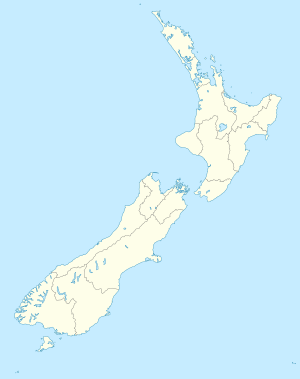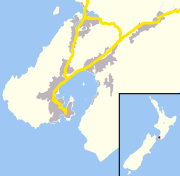Naenae facts for kids
Quick facts for kids
Naenae
|
|
|---|---|
|
Suburb
|
|
 |
|
| Country | New Zealand |
| Local authority | Lower Hutt |
| Electoral ward | Eastern |
| Area | |
| • Land | 518 ha (1,280 acre) |
| Population
(June 2023)
|
|
| • Total | 9,680 |
| Train station(s) | Naenae Railway Station |
|
|
||
Naenae (/ˈnaɪnaɪ/, occasionally spelled NaeNae) is a suburb of Lower Hutt, New Zealand. It lies on the eastern edge of the floodplain of the Hutt River, four kilometres from the Lower Hutt Central business district. A small tributary of the Hutt, the Waiwhetū Stream, flows through the suburb. Naenae lies 19.7 km from Wellington Central.
Contents
Toponymy
Naenae or nae-nae is a translation from the Māori, meaning "mosquito" or "sandfly", and is widely believed to recall a time prior to the draining of the area, when the mosquito population predominated. The New Zealand Geographic Board authorised Naenae as a correct spelling in 1929.
However, the name of the suburb 'Naenae' is an incorrect recording by settler populations of the traditional Māori name 'Te Ngaengae.' In fact, 'Naenae’ is derived from 'Te Ngaengae', which means ‘to cause effect through rupture’. The story of Naenae begins with Māui raising the fish Hāhā-te-Whenua, and his brothers cutting the fish and creating mountains, lakes and rivers. There was a freshwater lake where Naenae cemetery is now. Two man-eating taniwha dwelled there, and people were banned from going into the water because they would disappear. One day a child slipped in and the two taniwha raced towards the child and tore each other apart. Thus two rivers were created: Waiwhetū and Te Awamutu. Taniwha are unexplained phenomena, not necessarily the large monsters they are often represented as. Te Ngaengae could be ‘a volcanic activity underwater’. Maui’s fish was called Hāhā-te-Whenua – a reference to plates shifting under the water.
Setting
Naenae occupies a basin and the lower slopes of the Eastern Hutt Hills in the upper reaches of the Waiwhetū Stream catchment area.
Waiwhetū Stream
The stream has its headwaters in the Eastern Hutt hills, above the suburbs of Wingate and Naenae in Lower Hutt. It has a catchment area of around 18 square kilometres (1,800 ha). The stream is around 9 kilometres (5.6 mi) in length and passes through the eastern suburbs of Fairfield, Waterloo, and Waiwhetū, and the industrial areas of Seaview and Gracefield before entering the estuary of the Hutt River Te Awa Kairangi as it reaches Wellington Harbour.
History
From the early days of European settlement, land in the area around Naenae and Taitā had been used for market gardens, and had supplied vegetables for the Wellington region.
As Lower Hutt expanded after the end of World War II in 1945, the Labour Party government under Peter Fraser selected Naenae as an ideal site to become a "designer community", a model suburb of sorts, where a suburban state-housing estate would complement a substantial shopping centre. This community centre would serve as a social hub for the greater area. The planners hoped to encourage nuclear-family life in such a scheme. Due to the increasing urbanization of New Zealand, demand for housing outstripped the need for such centres, leaving the scheme only partially realised .
Ernst Plischke, an Austrian architect, designed plans for the new community centre between 1942 and 1943. However, government architect Gordon Wilson later drastically changed the design.
Naenae Railway Station (opened 1946), on the Hutt Valley section of the Wairarapa Line, adjoins Naenae's shopping centre.
Naenae's post-modern Post Office building, (officially opened in 1966, closed as a postal centre in 2016) pays homage to the Art Deco era Main Post Office in Lower Hutt town centre.
A re-zoning of Naenae made it partly industrial in the 1960s, but it remained principally a residential area. At its peak, Naenae boasted two manufacturers with strong Dutch connections:
- Philips, which produced televisions and radios. The last television set produced in this factory was made on 11 June 1988. Resene Paints occupied the buildings as of 2007[update].
- Rembrandt Suits, formed following the Second World War by Dutch tailors. It moved out of its 1950s era Naenae factory in 2012.
Swimming pool
Naenae's shopping centre contained an Olympic-size swimming-pool, built when New Zealand hosted an international diving championships. The pool was opened on 10 November 1956, and had three diving boards. Originally open-air, a roof over the pool was completed in 1987, making it usable all year round. A hydroslide was constructed adjacent to the main pool in the same project. The toddlers' paddling pool remained open-air for a few years more. At the time of the completion of the roof, the pool was the only facility in Wellington with both a 50 metre pool and competition diving platforms.
The pool closed in April 2019 due to earthquake concerns. In 2021, the Hutt City Council approved a budget of $68m for replacing the pool as part of their 10-year plan. In 2020, the council had funding support of $27m from central government. Demolition of the original pool began in 2021, in preparation for redevelopment. In 2022, the former Community Hall was demolished in preparation for building a new Naenae Pool and Fitness Centre that includes an Olympic size pool with 10 lanes. Other projects include refurbishing the library, building a new community centre, and redeveloping Walter Mildenhall park.
Demographics
Naenae, comprising the statistical areas of Naenae Central, Naenae North and Naenae South, covers 5.18 km2 (2.00 sq mi). It had an estimated population of 9680 as of June 2023, with a population density of 1869 people per km2.
| Historical population | ||
|---|---|---|
| Year | Pop. | ±% p.a. |
| 2006 | 8,286 | — |
| 2013 | 8,184 | −0.18% |
| 2018 | 8,700 | +1.23% |
Naenae had a population of 8,700 at the 2018 New Zealand census, an increase of 516 people (6.3%) since the 2013 census, and an increase of 414 people (5.0%) since the 2006 census. There were 2,913 households, comprising 4,272 males and 4,422 females, giving a sex ratio of 0.97 males per female, with 2,046 people (23.5%) aged under 15 years, 1,980 (22.8%) aged 15 to 29, 3,831 (44.0%) aged 30 to 64, and 843 (9.7%) aged 65 or older.
Ethnicities were 53.6% European/Pākehā, 29.3% Māori, 24.5% Pasifika, 10.9% Asian, and 3.9% other ethnicities. People may identify with more than one ethnicity.
The percentage of people born overseas was 23.1, compared with 27.1% nationally.
Although some people chose not to answer the census's question about religious affiliation, 42.7% had no religion, 41.2% were Christian, 2.1% had Māori religious beliefs, 1.8% were Hindu, 1.5% were Muslim, 1.1% were Buddhist and 2.5% had other religions.
Of those at least 15 years old, 945 (14.2%) people had a bachelor's or higher degree, and 1,692 (25.4%) people had no formal qualifications. 573 people (8.6%) earned over $70,000 compared to 17.2% nationally. The employment status of those at least 15 was that 3,096 (46.5%) people were employed full-time, 855 (12.8%) were part-time, and 519 (7.8%) were unemployed.
| Name | Area (km2) |
Population | Density (per km2) |
Households | Median age | Median income |
|---|---|---|---|---|---|---|
| Naenae Central | 1.38 | 3,420 | 2,478 | 1,158 | 33.4 years | $24,200 |
| Naenae North | 2.61 | 2,535 | 967 | 855 | 33.0 years | $24,500 |
| Naenae South | 1.18 | 2,745 | 2,326 | 900 | 30.6 years | $25,900 |
| New Zealand | 37.4 years | $31,800 |
Education
Naenae has four schools:
- Naenae School is a state contributing primary (Year 1–6) school serving the southern half of the suburb. It has 288 students as of February 2024.
- Rata Street School is a state contributing primary (Year 1–6) school serving the northern half of the suburb. It has 260 students as of February 2024.
- St Bernadette's School is a state-integrated Catholic full primary and intermediate (Year 1–8) school. It has 102 students as of February 2024.
- Wa Ora Montessori School is a state-integrated Montessori composite (Year 1–13) school. It has 262 students as of February 2024.
State intermediate students (Year 7–8) and secondary students (Year 9–13) are served by St Bernadette's School, Naenae Intermediate School and Naenae College respectively, which despite their names are located in the adjacent suburb of Avalon.
Notable people
People who have grown up or lived in Naenae include:
- Bob Jones - businessman
- Brooke Fraser - singer
- Andy Anderson - actor
- Billy Graham - boxer
- Julian Dennison - actor
- Dan Wootton - journalist and broadcaster
- Aaron Tokona - guitarist and singer
- Monica Galetti - chef
- Stephen Kós - judge of the Supreme Court and President of Court of Appeal
- Shaun Easthope - footballer
- Asafo Aumua - rugby player



